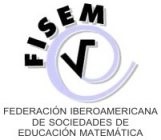Uso de gestos –como recurso-mediador– por un profesor de bachillerato para enfrentar un desafío didáctico no previsto por él
Resumo
En este artículo se reporta cómo un profesor de bachillerato (niveles 10-12) usó gestos al enfrentarse a una situación en el aula no prevista por él. El uso de gestos ocurrió durante la interacción con tres estudiantes en torno al análisis del movimiento de un objeto en caída libre. Se llevó a cabo un análisis cualitativo de los datos a partir de un marco conceptual que coordina elementos de tres aproximaciones teóricas: aproximación documental de lo didáctico, la teoría de actividad y la epistemología histórica. La recopilación de datos se llevó a cabo mediante la videograbación de la interacción profesor-estudiantes al momento de tratar de dar significado al movimiento de un objeto en caída libre. Consideramos que el análisis de resultados muestra que la coordinación de gestos es, por una parte, un recurso semiótico que debe considerarse relevante en el sistema de recursos de los profesores; y por otra parte, representan, en sí mismo, una manera de visualizar la estructura cognitiva que guía las acciones del profesor.
Downloads
Referências
Adler, J. (2000). Conceptualising resources as a theme for teacher education. Journal of Mathematics Teacher Education, 3(3), 205-224.
Arzarello, F., Paola, D., Robutti, O. & Sabena, C. (2009). Gestures as semiotic resources in the mathematics classroom. Educational Studies in Mathematics, 70(2), 97-109.
Engeström, Y. (2001). Expansive Learning at Work: Toward an activity theoretical reconceptualization. Journal of Education and Work, 14(1), 133-156. https://doi.org/10.1080/13639080020028747
Giancoli, D. (2006). Física. Principios con aplicaciones. México: Pearson Educación.
Gueudet, G., & Trouche, L. (2009). Towards new documentation system for mathematics Teachers? Educational Studies in Mathematics, 71, 199-218.
Gueudet, G., & Trouche, L. (2012). Teachers´work with resources: Documentational geneses and professional geneses. In G. Gueudet, B. Pepin, & L. Trouche (Eds.), From text to ´lived´resources: Mathematics curriculum materials and teacher development (pp.189-213). New York: Springer.
Guzmán, J., & Kieran, C. (2013). Becoming aware of mathematical gaps in new curricular materials: A resource-based analysis of teaching practice. The Mathematics Enthusiast, 10(1-2), 163-190.
Haquin, D. M. (2012). La perspectiva multimodal sobre la comunicación: desafíos y aportes para la enseñanza en el aula. Diálogos educativos, 11(22), 3-14.
Karam, R. (2015). Introduction of the Thematic Issue on the Interplay of Physics and Mathematics. Science & Education, 24(56), 487-494.
Kjeldsen, T. H., & Lützen, J. (2015). Interactions Between Mathematics and Physics: The History of the Concept of Function—Teaching with and About Nature of Mathematics. Science & Education, 24(5-6), 543-559.
Kragh, H. (2015). Mathematics and physics: The idea of a pre-established harmony. Science & Education, 24(5-6), 515-527.
Leont’ev, A. N. (1978). Activity, consciousness, and personality. Englewood Cliffs, NJ: Prentice-Hall.
Piaget, J. (1979). Introducción a la epistemología genética: El pensamiento físico. Argentina: Paidós.
Radford, L. (2006). Elementos de una teoría cultural de la objetivación. Revista Latinoamericana de Investigación en Matemática Educativa, 9(Extraordinario 1), 103-129.
Radford, L. (2008). The ethics of being and knowing: Towards a cultural theory of learning. In L. Radford, G. Schubring, & F. Seeger (Eds.), Semiotics in mathematics education: epistemology, history, classroom, and culture (pp. 215-234). Rotterdam: Sense Publishers.
Radford, L. (2009). Why do gestures matter? Sensuous cognition and the palpability of mathematical meanings. Educational Studies in Mathematics, 70(3), 111-126.
Radford, L. (2012). On the cognitive, epistemic, and ontological roles of artifacts. In G. Gueudet, B. Pepin, & L. Trouche, (Eds.), From text to ´lived´resources: Mathematics curriculum materials and teacher development (pp. 238-288). New York: Springer.
Resnick, R., & Halliday, D. (1970). Física: Vol. 1. México: CECSA.
Salinas-Hernández, U., & Miranda, I. (2018). Relating Computational Cartesian Graphs to a Real Motion: An Analysis of High School Students’ Activity. In N. Presmeg, L. Radford, W.M. Roth, & G. Kadunz G. (Eds.), Signs of Signification (pp. 55-71). ICME-13 Monographs. Cham: Springer. https://doi.org/10.1007/978-3-319-70287-2_4
Trouche, L., Gitirana, V., Miyakawa, T., Pepin, B., & Wang, C. (Online first). Studying mathematics teachers interactions with curriculum materials through different lenses: towards a deeper understanding of the processes at stake. In J. Choppin (Ed.), special issue Curriculum ergonomics, International Journal of Educational Research, available at https://doi.org/10.1016/j.ijer.2018.09.002
Wartofsky M. (1979). Models: representation and the scientific understanding. Boston studies in the philosophy of science, vol. XLVIII. Boston (MA): Reidel Publishing Company.
O material publicado na revista é distribuído sob a licença Creative Commons International Attribution 4.0 (CC-BY 4.0). Esta licença permite que outros distribuam, misturem, ajustem e desenvolvam seu trabalho, mesmo para fins comerciais, desde que você seja creditado com a criação original. Os autores das obras publicadas na Revista Unión mantêm seus direitos autorais sem restrições.
##plugins.generic.dates.published## 2018-12-01







.png)






